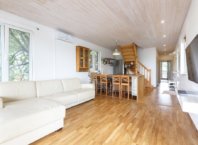The introduction of glue laminated timber is one of the most versatile and convenient developments in wooden construction. First properly developed towards the end of the 19th century, it made possible many structures with arches and curvature using wood.
Glulam is made from bonding together pieces or planks of smaller wood or timber together by industrial grade adhesives and glues. Not only are they bonded together but they are also coated and treated with these chemicals to give them lamination.
Glulam has many substantial advantages over conventional timber which have made it the preferred form of timber for construction uses.

Briefly, some of these advantages are:
- Sustainable
Glulam is a sustainable means of timber production since it can use every type of wood possible from young and fast growing trees to high quality Australian hardwood. This allows for it to be made at a faster pace and old dense forests don’t have to be cut down for timber.
- Wider Availability
Because it can be made from any type of wood, glulam is mostly made from fast growing young trees. This means it is more easily available everywhere and thus presents a more convenient option than conventional timber.
- Cost
Because of the above two reasons, glulam also is significantly cheaper than other industrial materials like steel and concrete. It can be easily and repeatedly sourced and does not require a lot of materials for production.
- Versatile
Glulam is a versatile and multipurpose input because of the process by which it is made. Bonding smaller pieces of wood together means it can be shaped and formed to any pre-existing structure or shape thus making curvature possible.
- Resistant
Because glulam is laminated and bonded with industrial grade adhesives, it does have any porous openings like normal wood for water to penetrate. It is very resistant and durable against nature’s elements.
- Strength
One of the best qualities of glulam timber is that despite being cheaper than conventional timber and made from smaller pieces of wood, it is actually far stronger and more resistant than conventional timber.
The adhesives and glues used to make it significantly improve its ability to bear wear and tear and pressure.
These are some of the major advantages that glulam timber offers over other construction materials. Because of these benefits it offers, it is one of the prime choices for construction purposes for both internal and external purposes ever since hydrophobic glue was developed in 1942.
Here are some of the major applications of glulam timber in the modern world:
1. Sports Venues
Glulam is prominently used by the sports construction industry. Many venues and famous stadiums have been constructed with glulam.
Glulam is primarily used for the roofs of such structures and this goes back around to the advantages we discussed. The ability of glulam to take on various shapes perfectly pairs with the curved roofing of most sporting structures and its lightweight yet durability and ability to cover large areas proves to be a blessing for stadium constructions.
2. Bridges
Glulam is also used for the construction of bridges. Glulam is particularly suited for the needs of bridges and is a far safer and dependable material to use than any form of conventional timber.
The reason for that lies in the durability of glulam and its increased ability over conventional timber to absorb pressure and its ability to stand the test of time.
These qualities make it ideal for bridge construction of any kind since a bridge by nature has to support the weight of numerous daily on-goings. Materials which don’t have enough resistance for wear and tear and may break after repeated strenuous use are, therefore, not suitable for the construction of bridges.
3. Religious Buildings
The opulence and wealth associated with some notable places of worship and religious buildings have increasingly brought religions under public attack. Attacks of frivolous wealth spending and disregard for the environment are a common criticism.
To that end, glulam offers a viable solution to this headache. It is cheap and it is environmentally sustainable while still offering great aesthetic appeal.
4. Housing
Due to many of its qualities like its lower cost, adaptability and nature resistance, glulam is increasingly being used for the construction of homes as well.
Glulam is used for the construction of both the interior and exterior of a home. Using it in the interior gives a classic laminated and elegant look to the wooden walls but more practically, it is fire resistant which can be of great help in case a fire breaks out. Its adaptability means people can build all sorts of structures like curved roofs or patios from glulam while not heavily denting their pockets.
External applications include glulam roofing to prevent water seepage and leakage, thus providing protection from water damage and water inundation. Rainwater is not absorbed into glulam timber and runs off since it is laminated with adhesives.
5. Storm Shelters
The standard procedure for category 4 storms and above is mass evacuation. This is because conventional timber often cannot stand the force of wind and rain in such storms.
Glulam is now being looked into as a viable material for stormproof housing and shelters. This is because the water-resistant qualities of glulam make it a perfect defense against the torrential downpour of a storm. Additionally, its sturdiness, durability, and ability to withstand wear and tear make it particularly suited to brave the forces in a storm.
Conclusion
If one were to make an exhaustive list of the uses and applications of glulam timber then that would be beyond the scope of this blog post. Generally speaking, these are some of the more common applications of glulam timber in construction. As time and research move on, we may further find uses for glulam that are undiscovered as of yet.
About Author:-
Simon is an entrepreneur and self-proclaimed jack of all trades. Simon has experience in the building and home renovation industry and he knows what it takes to knock out a successful project whether it be commercial or residential. Currently, he works as a marketing consultant with ASH – a prominent supplier of various types of timber, like timber battens, Glulam, Australian Oak, etc. Another niche for Simon is travel and outdoors leisure, including sporting equipment and bikes. A big kid at heart if it goes fast, bounces, slides or you can climb it Simon has put it to the test.







